Characterizing Various Produced Waters from Shale Energy Extraction within the Context of Reuse
Abstract
:1. Introduction
2. Methods and Materials
2.1. Samples
2.2. Compositional Analyses
3. Results and Discussion
3.1. Bulk Measurements and Basic Parameters
3.2. Metals
3.3. Anions
3.4. Permian Basin Salt Water Disposal Samples Compared to National Values
3.5. Treatment Required for Direct Reuse and Beneficial Reuse
4. Conclusions
Supplementary Materials
Author Contributions
Funding
Institutional Review Board Statement
Informed Consent Statement
Data Availability Statement
Acknowledgments
Conflicts of Interest
References
- Kim, S.; Omur-Ozbek, P.; Dhanasekar, A.; Prior, A.; Carlson, K. Temporal analysis of flowback and produced water composition from shale oil and gas operations: Impact of frac fluid characteristics. J. Pet. Sci. Eng. 2016, 147, 202–210. [Google Scholar] [CrossRef]
- Mobilia, M.; Comstock, O. U.S. Energy Consumption Rose Slightly in 2016 Despite a Significant Decline in Coal Use. 2017. Available online: https://www.ajot.com/news/u.s.-energy-consumption-rose-slightly-in-2016-despite-a-significant-decline (accessed on 19 April 2022).
- U.S. Energy Information Administration. Monthly Energy Review—April 2017; EIA: Washington, DC, USA, 2017.
- Liden, T.; Clark, B.G.; Hildenbrand, Z.L.; Schug, K.A. Unconventional Oil and Gas Production: Waste Management and the Water Cycle. In Environmental Issues Concerning Hydraulic Fracturing; Schug, K.A., Hildenbrand, Z.L., Eds.; APMP, Academic Press: Oxford, UK, 2017; Volume 1, pp. 17–45. [Google Scholar] [CrossRef]
- Hildenbrand, Z.L.; Santos, I.C.; Liden, T.; Carlton, D.D.; Varona-Torres, E.; Martin, M.S.; Reyes, M.L.; Mulla, S.R.; Schug, K.A. Characterizing variable biogeochemical changes during the treatment of produced oilfield waste. Sci. Total Environ. 2018, 634, 1519–1529. [Google Scholar] [CrossRef] [PubMed]
- Thacker, J.B.; Carlton, D.D., Jr.; Hildenbrand, Z.L.; Kadjo, A.; Schug, K.A. Chemical Analysis of Wastewater from Unconventional Drilling Operations. Water 2015, 7, 1568–1579. [Google Scholar] [CrossRef] [Green Version]
- Ground Water Protection Council, All Consulting. Modern Shale Gas—A Primer. 2009. Available online: https://www.energy.gov/fecm/downloads/modern-shale-gas-development-united-states-primer (accessed on 17 April 2022).
- Shaffer, D.; Chavez, L.H.A.; Ben-Sasson, M.; Castrillo, S.R.; Yin Yip, N.; Elimelech, M. Desalination and Reuse of High-Salinity Shale Gas Produced Water: Drivers, Technologies, and Future Directions. Environ. Sci. Technol. 2013, 47, 9569–9583. [Google Scholar] [CrossRef]
- Scanlon, B.R.; Reedy, R.C.; Xu, P.; Engle, M.; Nicot, J.P.; Yoxtheimer, D.; Yang, Q.; Ikonnikova, S. Can we beneficially reuse produced water from oil and gas extraction in the US? Sci. Total Environ. 2020, 717, 137085. [Google Scholar] [CrossRef]
- Nicot, J.P.; Scanlon, B.R.; Reedy, R.C.; Costley, R.A. Source and Fate of Hydraulic Fracturing Water in the Barnett Shale: A Historical Perspective. Environ. Sci. Technol. 2014, 48, 2464–2471. [Google Scholar] [CrossRef]
- Mantell, M. Produced Water Reuse and Recycling Challenges and Opportunities across Major Shale Plays. In EPA Hydraulic Fracturing Study Technical Workshop #4 Water Resources Management March; Chesapeake Energy Corporation: Oklahoma City, OK, USA, 2011; pp. 1–49. [Google Scholar]
- Ewing, B.T.; Waston, M.C.; McInturff, T.; McInturff, R. Economic Impact of the Permian Basin Oil and Gas Industry; Uddameri, V., Morse, A., Tindle, K.J., Eds.; CRC Press: Boca Raton, FL, USA, 2014; pp. 1–80. [Google Scholar]
- Scanlon, B.R.; Reedy, R.C.; Male, F.; Walsh, M. Water Issues Related to Transitioning from Conventional to Unconventional Oil Production in the Permian Basin. Environ. Sci. Technol. 2017, 51, 10903–10912. [Google Scholar] [CrossRef]
- Backstrom, J. Groundwater Regulations and Hydraulic Fracturing: Reporting Water Use in the Permian, College Station, TX, USA. 2018. Available online: https://agecograds.tamu.edu/wp-content/uploads/sites/49/2018/02/Groundwater-Regulations-and-Hydraulic-Fracturing-Reporting-Water-Use-in-Texas.pdf (accessed on 19 April 2022).
- Barclays, Columbia Water Center. The Water Challenge: Preserving a Global Resource. 2017. Available online: https://www.cib.barclays/content/dam/barclaysmicrosites/ibpublic/documents/our-insights/water-report/ImpactSeries_WaterReport_Final.pdf (accessed on 19 April 2022).
- Arthur, D.J.; Bohm, B.; Coughlin, B.J.; Layne, M.; Cornue, D. Evaluating the Environmental Implications of Hydraulic Fracturing in Shale Gas Reservoirs. In Proceedings of the SPE Americas E&P Environmental and Safety Conference, San Antonio, TX, USA, 23 March 2008; pp. 1–21. [Google Scholar] [CrossRef] [Green Version]
- Clark, C.E.; Veil, J.A. Produced Water Volumes and Management Practices in the United States; Argonne National Laboratory: Argonne, IL, USA, 2009. [CrossRef] [Green Version]
- Railroad Commission of Texas. Injection and Disposal Wells. 2017. Available online: http://www.rrc.state.tx.us/about-us/resource-center/faqs/oil-gas-faqs/faq-injection-and-disposal-wells/ (accessed on 7 July 2017).
- Van der Elst, N.J.; Page, M.T.; Weiser, D.A.; Goebel, T.H.W.; Hosseini, S.M. Induced earthquake magnitudes are as large as (statistically) expected. J. Geophys. Res. Solid Earth 2016, 121, 4575–4590. [Google Scholar] [CrossRef]
- Gallegos, T.J.; Varela, B.A.; Haines, S.S.; Engle, M.A. Hydraulic fracturing water use variability in the United States and potential environmental implications. Water Resour. Res. 2015, 51, 5839–5845. [Google Scholar] [CrossRef]
- Hornbach, M.J.; DeShon, H.R.; Ellsworth, W.L.; Stump, B.W.; Hayward, C.; Frohlich, C.; Oldham, H.R.; Olson, J.E.; Magnani, M.B.; Brokaw, C.; et al. Causal factors for seismicity near Azle, Texas. Nat. Commun. 2015, 6, 6728. [Google Scholar] [CrossRef] [Green Version]
- Hornbach, M.J.; Jones, M.; Scales, M.; DeShon, H.R.; Magnani, M.B.; Frohlich, C.; Stump, B.; Hayward, C.; Layton, M. Ellenburger wastewater injection and seismicity in North Texas. Phys. Earth Planet. Inter. 2016, 261, 54–68. [Google Scholar] [CrossRef] [Green Version]
- Magnani, M.B.; Blanpied, M.L.; DeShon, H.R.; Hornbach, M.J. Discriminating between natural versus induced seismicity from long-term deformation history of intraplate faults. Sci. Adv. 2017, 3, e1701593. [Google Scholar] [CrossRef] [PubMed] [Green Version]
- Wang, Q.; Chen, X.; Jha, A.N.; Rogers, H. Natural gas from shale formation-The evolution, evidence, and challenges of shale gas revolution in United States. Renew. Sustain. Energy Rev. 2014, 30, 1–28. [Google Scholar] [CrossRef]
- Jula, M. In Oklahoma, Injecting Less Saltwater Lowers Quake Rates. Sci. Magzine 2016, 2016–2019. Available online: https://www.aaas.org/news/oklahoma-injecting-less-saltwater-lowers-quake-rates (accessed on 19 April 2022).
- Parker, K.M.; Zeng, T.; Harkness, J.; Vengosh, A.; Mitch, W.A. Enhanced formation of disinfection byproducts in shale gas wastewater-impacted drinking water supplies. Environ. Sci. Technol. 2014, 48, 11161–11169. [Google Scholar] [CrossRef]
- King, G.E. Treating Produced Water for Shale Fracs; Society of Petroleum Engineers Gulf Coast Section: Houston, TX, USA, 2011; pp. 1–20. [Google Scholar]
- Liden, T.; Santos, I.C.; Hildenbrand, Z.L.; Schug, K.A. Treatment Modalities for the Reuse of Produced Waste from Oil and Gas Development. Sci. Total Environ. 2018, 643, 107–118. [Google Scholar] [CrossRef]
- Oetjen, K.; Chan, K.E.; Gulmark, K.; Christensen, J.H.; Blotevogel, J.; Borch, T.; Spear, J.R.; Cath, T.Y.; Higgins, C.P. Temporal characterization and statistical analysis of flowback and produced waters and their potential for reuse. Sci. Total Environ. 2018, 619–620, 654–664. [Google Scholar] [CrossRef]
- Hildenbrand, Z.L.; Carlton, D.D., Jr.; Fontenot, B.E.; Meik, J.M.; Walton, J.L.; Taylor, J.T.; Thacker, J.B.; Korlie, S.; Shelor, C.P.; Henderson, D.; et al. A Comprehensive Analysis of Groundwater Quality in The Barnett Shale Region. Environ. Sci. Technol. 2015, 49, 8254–8262. [Google Scholar] [CrossRef] [Green Version]
- Hildenbrand, Z.L.; Carlton, D.D., Jr.; Fontenot, B.E.; Meik, J.M.; Walton, J.L.; Thacker, J.B.; Korlie, S.; Shelor, C.P.; Kadjo, A.F.; Clark, A.; et al. Temporal variation in groundwater quality in the Permian Basin of Texas, a region of increasing unconventional oil and gas development. Sci. Total Environ. 2016, 562, 906–913. [Google Scholar] [CrossRef]
- Otton, J.K.; Mercier, T. Produced Water Brine and Stream Salinity, U.S. Geological Survey. Available online: https://water.usgs.gov/orh/nrwww/Otten.pdf (accessed on 19 April 2022).
- Wasylishen, R.; Fulton, S. Reuse of Flowback & Produced Water for Hydraulic Fracturing in Tight Oil. Calgary 2012, 34. Available online: https://hero.epa.gov/hero/index.cfm/reference/details/reference_id/2828355 (accessed on 19 April 2022).
- Ahmadun, F.-R.; Pendashteh, A.; Abdullah, L.C.; Biak, D.R.A.; Madaeni, S.S.; Abidin, Z.Z. Review of technologies for oil and gas produced water treatment. J. Hazard. Mater. 2009, 170, 530–551. [Google Scholar] [CrossRef]
- Hu, Y.; Mackay, E.; Ishkov, O.; Strachan, A. Predicted and Observed Evolution of Produced-Brine Compositions and Implications for Scale Management. SPE Prod. Oper. 2016, 31, 270–279. [Google Scholar] [CrossRef]
- Moghadasi, J.; Muller-Steinhagen, H.; Jamaialahmadi, M.; Sharif, A. Prediction of Scale Formation Problems in Oil Reservoirs and Production Equipment due to Injection of Incompatible Waters. Asia-Pac. J. Chem. Eng. 2006, 14, 545–566. [Google Scholar] [CrossRef]
- Lunevich, L.; Sanciolo, P.; Milne, N.; Gray, S.R. Silica Fouling in Coal Seam Gas Water Reverse Osmosis Desalination. Environ. Sci. Water Res. Technol. 2017, 3, 911–921. [Google Scholar] [CrossRef]
- Montgomery, C. Fracturing Fluid Components. In Effective and Sustainable Hydraulic Fracturing; Jeffrey, R., Ed.; Intech: Oxford, UK, 2013; pp. 25–45. [Google Scholar] [CrossRef] [Green Version]
- Esmaeilirad, N.; White, S.; Terry, C.; Prior, A.; Carlson, K. Influence of inorganic ions in recycled produced water on gel-based hydraulic fracturing fluid viscosity. J. Pet. Sci. Eng. 2016, 139, 104–111. [Google Scholar] [CrossRef]
- Fink, J.K. Water-Based Chemicals and Technology for Drilling, Completion, and Workover Fluids. In Water-Based Chemicals and Technology for Drilling, Completion, and Workover Fluids; Gulf Professional Publishing: Boston, MA, USA, 2015; pp. i–ii. [Google Scholar] [CrossRef]
- Gulbis, J.; Hodge, R.M. Fracturing Fluid Chemistry and Proppants; Economides, M.J., Boney, C., Eds.; Reservoir Stimulation: New York, NY, USA, 2000; p. 856. [Google Scholar] [CrossRef]
- King, G.E.; Durham, D. Chemicals in Drilling, Stimulation, and Production. In Environmental Issues Concerning Hydraulic Fracturing; Schug, K.A., Hildenbrand, Z.L., Eds.; APMP, Academic Press: Oxford, UK, 2017; Volume 1, pp. 47–63. [Google Scholar]
- U.S. Environmental Protection Agency. Evaluation of Impacts to Underground Sources of Drinking Water by Hydraulic Fracturing of Coalbed Methane Reservoirs; John Wiley & Sons: Hoboken, NJ, USA, 2004. [CrossRef]
- Jennings, H.; Muroski, F. Removal of Hydrogen Sulfide with Potassium Permanganate. Am. Water Work. Assoc. 1964, 56, 475–479. [Google Scholar]
- Chang, C.-Y.; Hsieh, Y.-H.; Hsu, S.-S.; Hu, P.-Y.; Wang, K.-H. The formation of disinfection by-products in water treated with chlorine dioxide. J. Hazard. Mater. 2000, 79, 89–102. [Google Scholar] [CrossRef]
- Hua, G.; Reckhow, D.A.; Kim, J. Effect of Bromide and Iodide Ions on the Formation and Speciation of Disinfection Byproducts during Chlorination. Environ. Sci. Technol. 2006, 40, 3050–3056. [Google Scholar] [CrossRef]
- Vashishtha, D.; Villalobos, J.; Jimenez, D. Use of Chemicals in Disinfection: Implications and Alternatives. Ind. Water World 2017. Available online: https://www.watertechonline.com/wastewater/article/16210939/use-of-chemicals-in-disinfection-implications-and-alternatives (accessed on 18 April 2022).
- Symons, J.M.; Krasner, S.W.; Simms, L.A.; Sclimenti, M. Measurement of THM and Precursor Concentrations Revisited: The Effect of Bromide Ion. J. Am. Water Works Assoc. 1993, 85, 51–62. [Google Scholar] [CrossRef]
- Murali Mohan, A.; Hartsock, A.; Bibby, K.J.; Hammack, R.W.; Vidic, R.D.; Gregory, K.B. Microbial Community Changes in Hydraulic Fracturing Fluids and Produced Water from Shale Gas Extraction. Environ. Sci. Technol. 2013, 47, 13141–13150. [Google Scholar] [CrossRef]
- Blondes, M.S.; Gans, K.D.; Rowan, E.L.; Thordsen, J.J.; Reidy, M.E.; Engle, M.A.; Kharaka, Y.K.; Thomas, B. U.S. Geological Survey National Produced Waters Geochemical Database. 2017. Available online: https://energy.usgs.gov/EnvironmentalAspects/EnvironmentalAspectsofEnergyProductionandUse/ProducedWaters.aspx#3822349-data (accessed on 1 January 2016).
- Zielinski, R.A.; Otton, J.K. Naturally Occurring Radioactive Materials (NORM) in Produced Water and Oil-Field Equipment—An Issue for the Energy Industry. 1999. Available online: https://pubs.usgs.gov/fs/fs-0142-99/fs-0142-99.pdf (accessed on 17 April 2022).
- Chang, H.; Liu, T.; He, Q.; Li, D.; Crittenden, J.; Liu, B. Removal of calcium and magnesium ions from shale gas flowback water by chemically activated zeolite. Water Sci. Technol. 2017, 76, 575–583. [Google Scholar] [CrossRef] [PubMed] [Green Version]
- Igunnu, E.T.; Chen, G.Z. Produced water treatment technologies. Int. J. Low Carbon Technol. 2014, 9, 157–177. [Google Scholar] [CrossRef] [Green Version]
- Kausley, S.B.; Malhotra, C.P.; Pandit, A.B. Treatment and reuse of shale gas wastewater: Electrocoagulation system for enhanced removal of organic contamination and scale causing divalent cations. J. Water Process Eng. 2017, 16, 149–162. [Google Scholar] [CrossRef]
- Khor, C.M.; Wang, J.; Li, M.; Oettel, B.A.; Kaner, R.B.; Jassby, D.; Hoek, E.M.V. Performance, energy and cost of produced water treatment by chemical and electrochemical coagulation. Water 2020, 12, 3426. [Google Scholar] [CrossRef]
- Cui, Y.; Ge, Q.; Liu, X.Y.; Chung, T.S. Novel forward osmosis process to effectively remove heavy metal ions. J. Membr. Sci. 2014, 467, 188–194. [Google Scholar] [CrossRef]
- Li, Y.; Wang, S.; Song, X.; Zhou, Y.; Shen, H.; Cao, X.; Zhang, P.; Gao, C. High boron removal polyamide reverse osmosis membranes by swelling induced embedding of a sulfonyl molecular plug. J. Membr. Sci. 2020, 597, 117716. [Google Scholar] [CrossRef]
- Coha, M.; Farinelli, G.; Tiraferri, A.; Minella, M.; Vione, D. Advanced oxidation processes in the removal of organic substances from produced water: Potential, configurations, and research needs. Chem. Eng. J. 2021, 414, 128668. [Google Scholar] [CrossRef]
- Zhao, S.; Hu, S.; Zhang, X.; Song, L.; Wang, Y.; Tan, M.; Kong, L.; Zhang, Y. Integrated membrane system without adding chemicals for produced water desalination towards zero liquid discharge. Desalination 2020, 496, 114693. [Google Scholar] [CrossRef]
- U.S. Department of Energy. Advancing Systems and Technologies to Produce Cleaner Fuels Technology Assessments: Unconventional Oil and Gas, Quadrennial Technology Review 2015; United State Department of Energy: Washington, DC, USA, 2015.
- Isa, M.H.; Ezechi, E.H.; Ahmed, Z.; Magram, S.F.; Kutty, S.R.M. Boron removal by electrocoagulation and recovery. Water Res. 2014, 51, 113–123. [Google Scholar] [CrossRef]
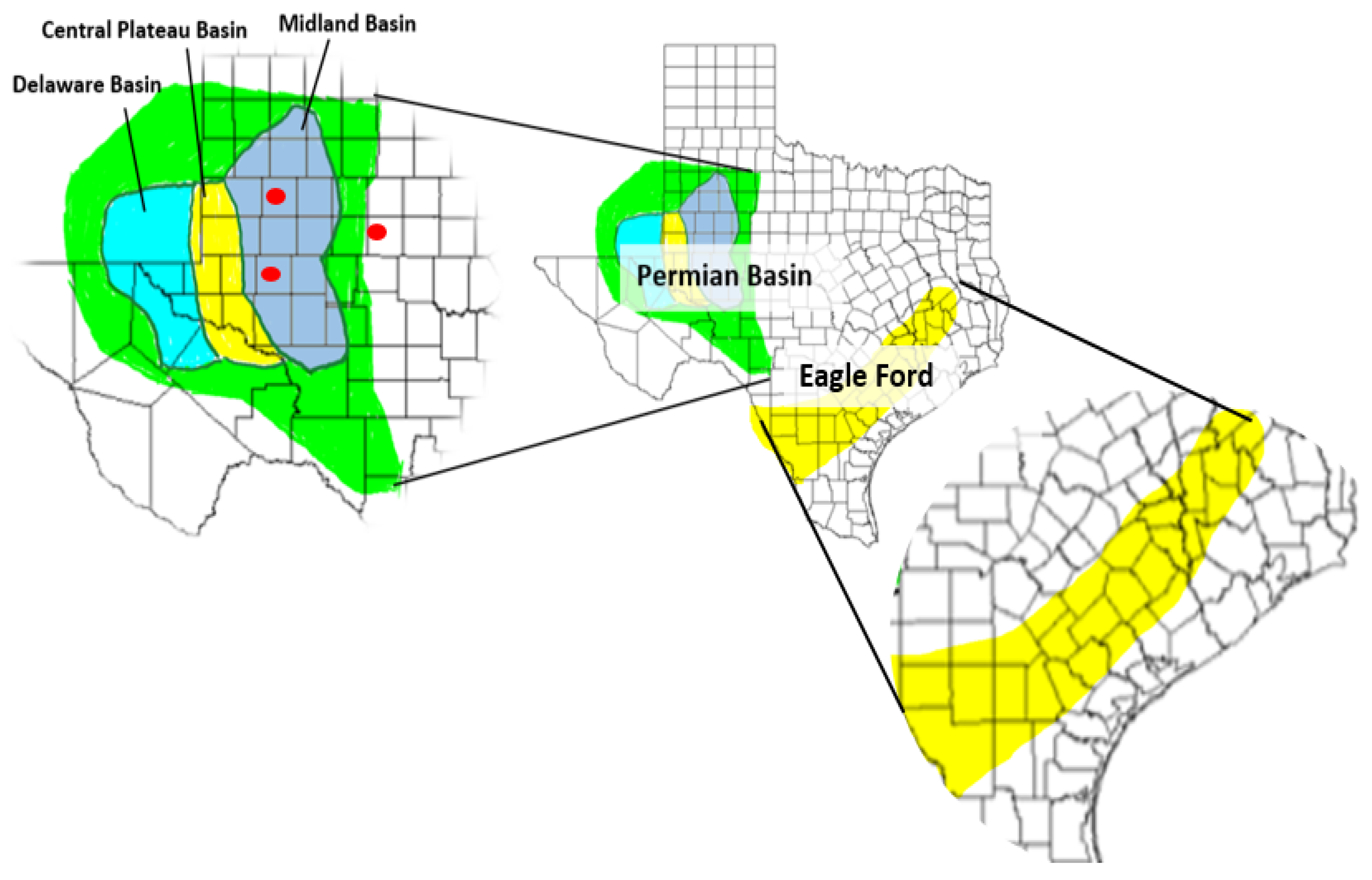
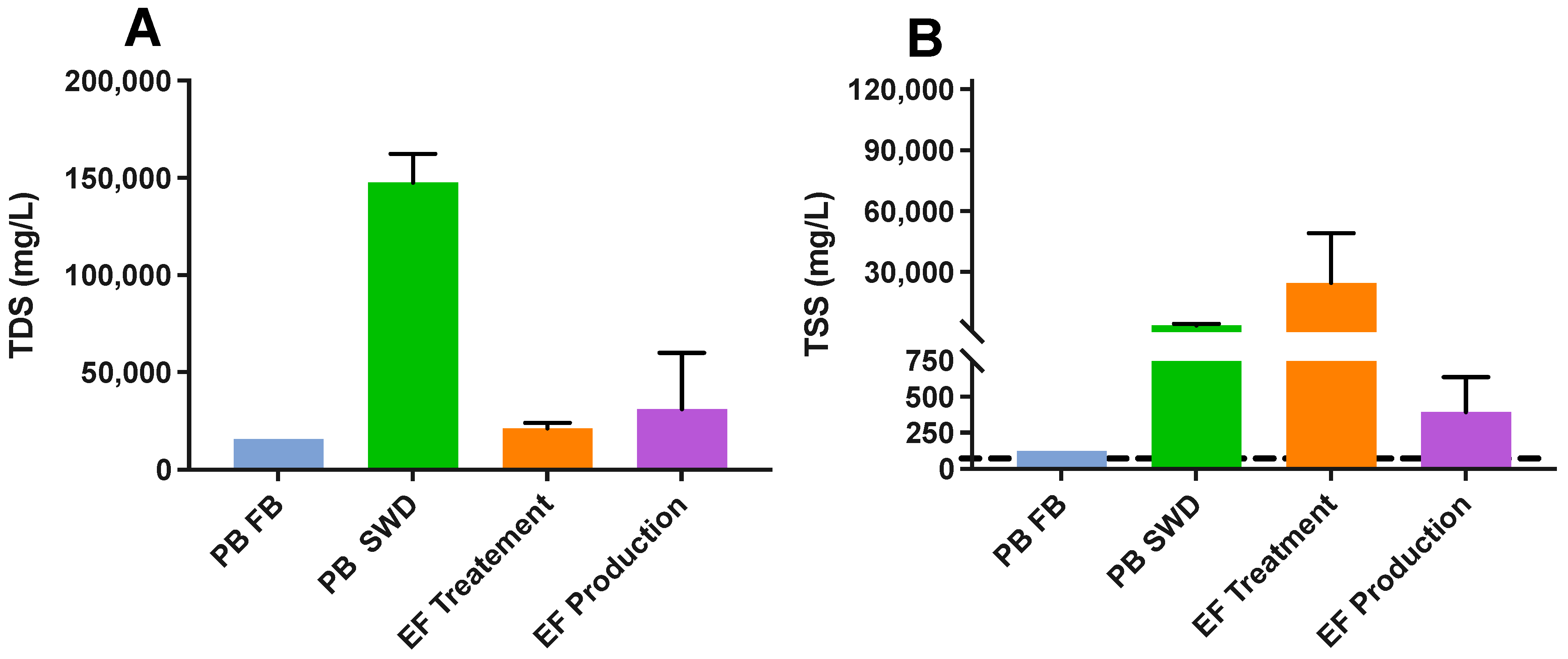

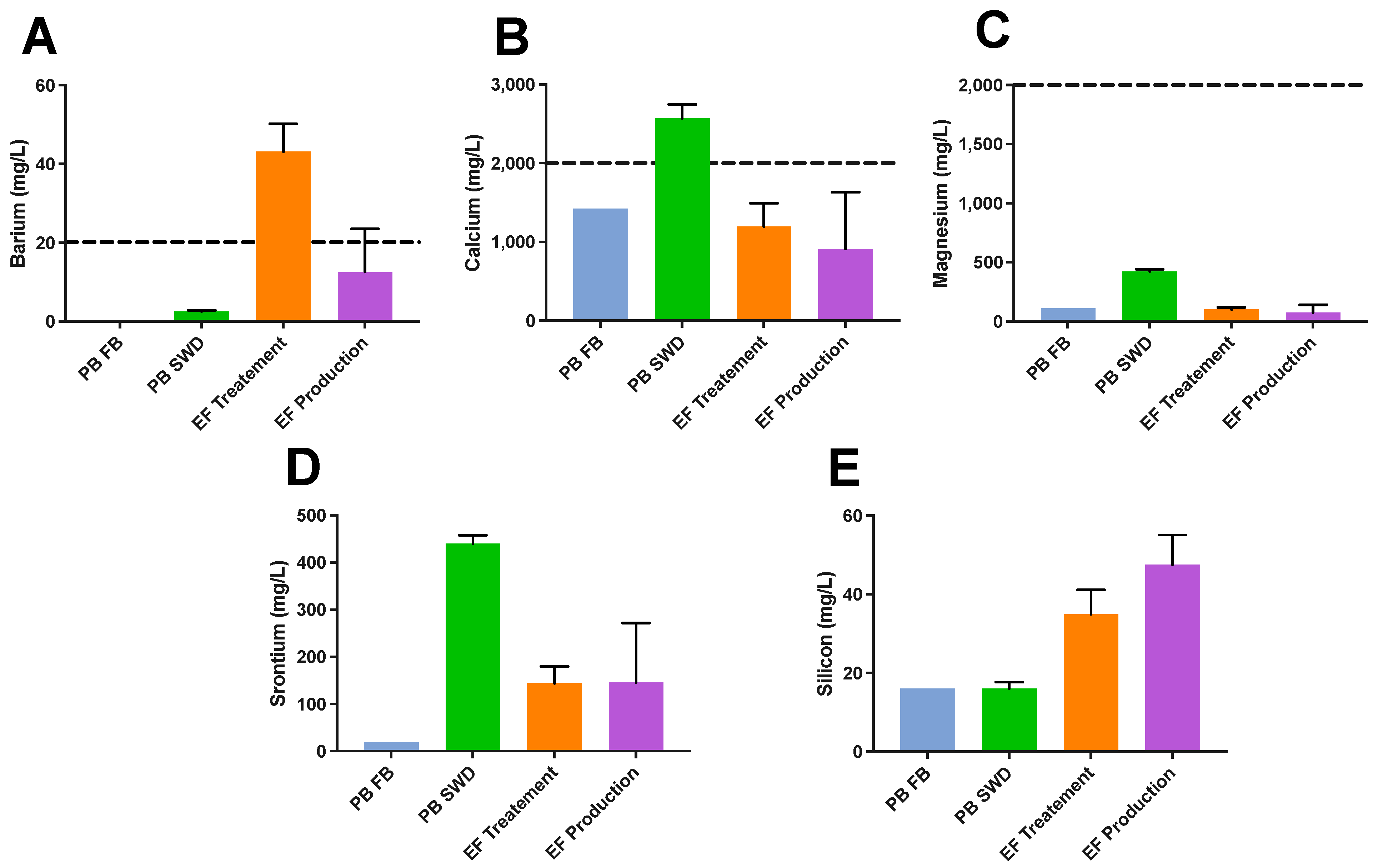
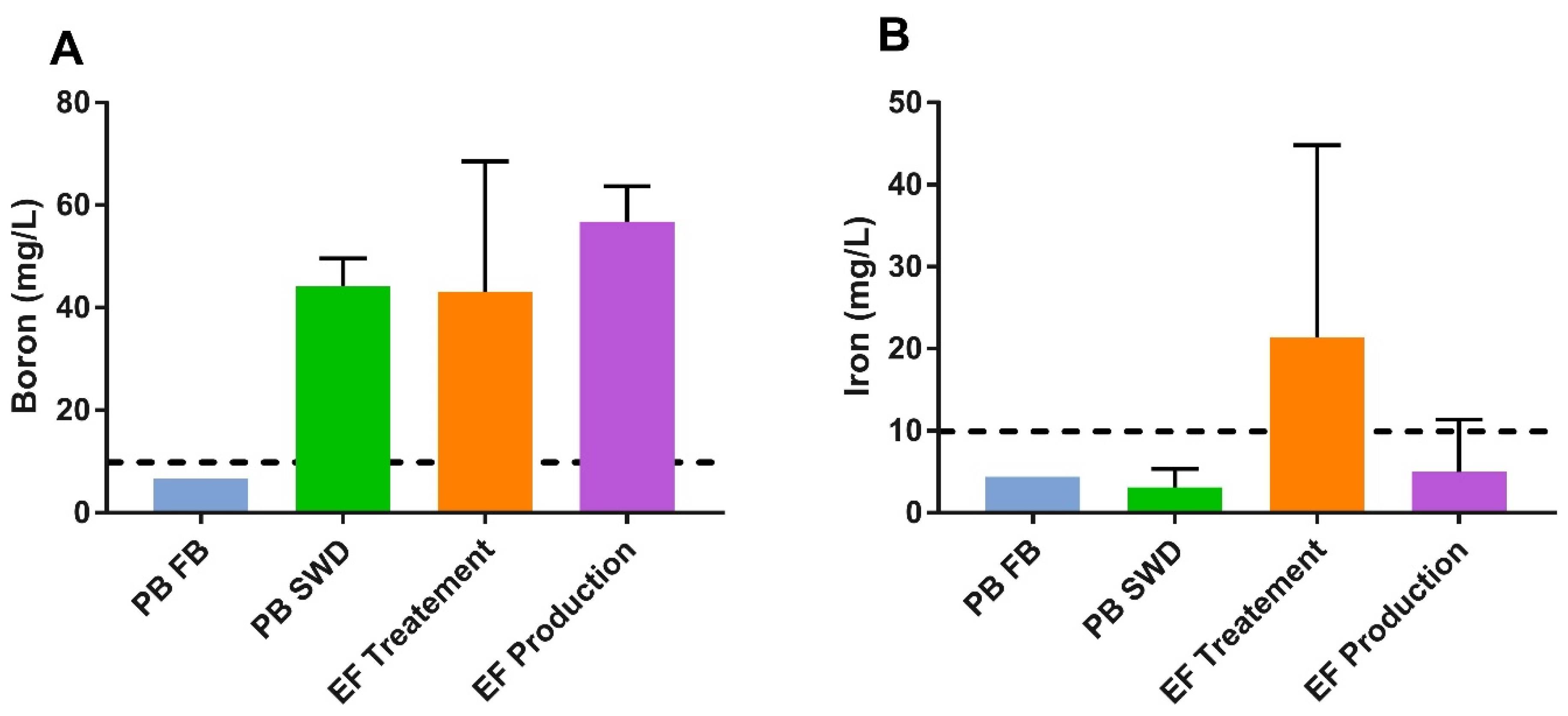
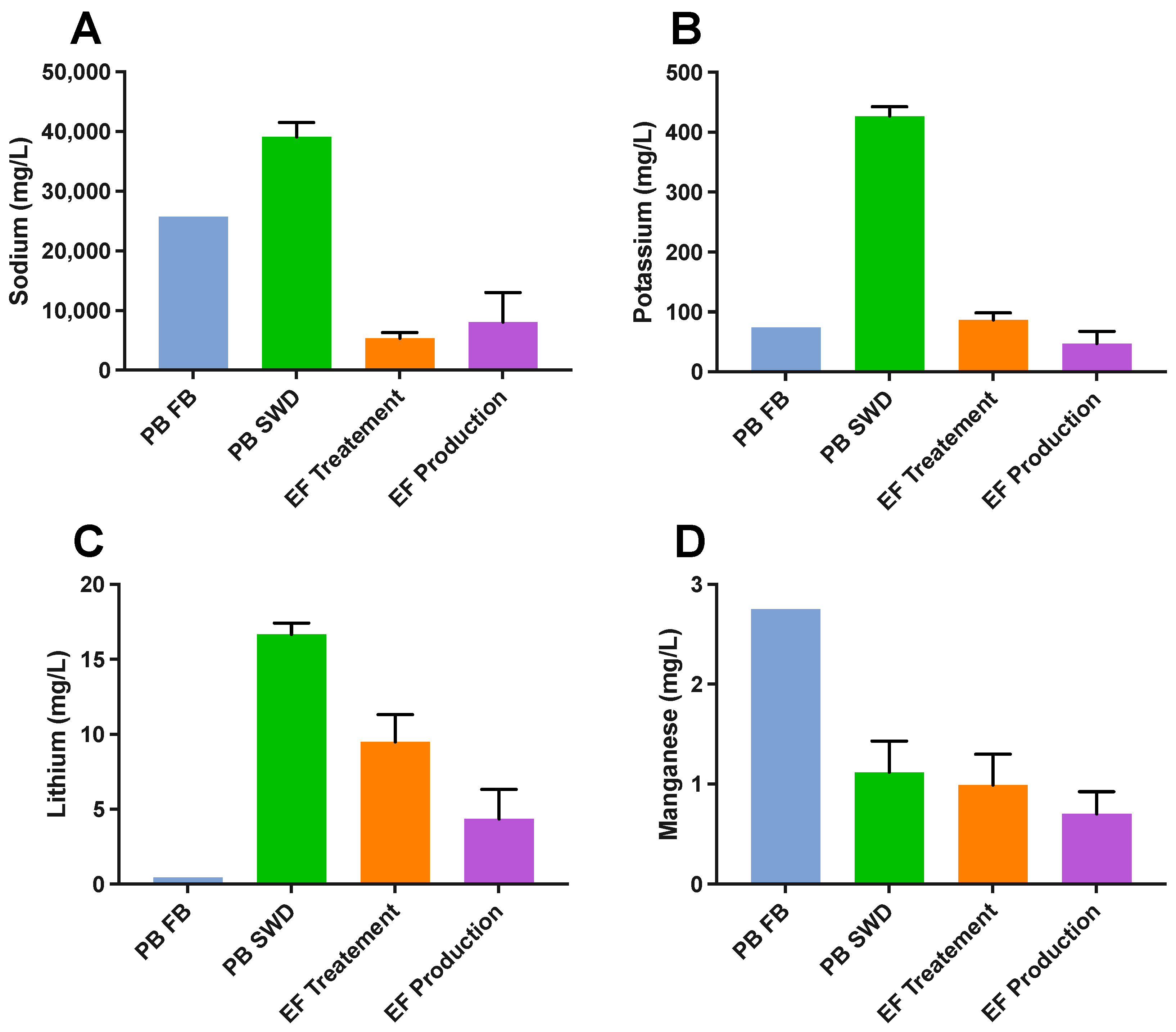

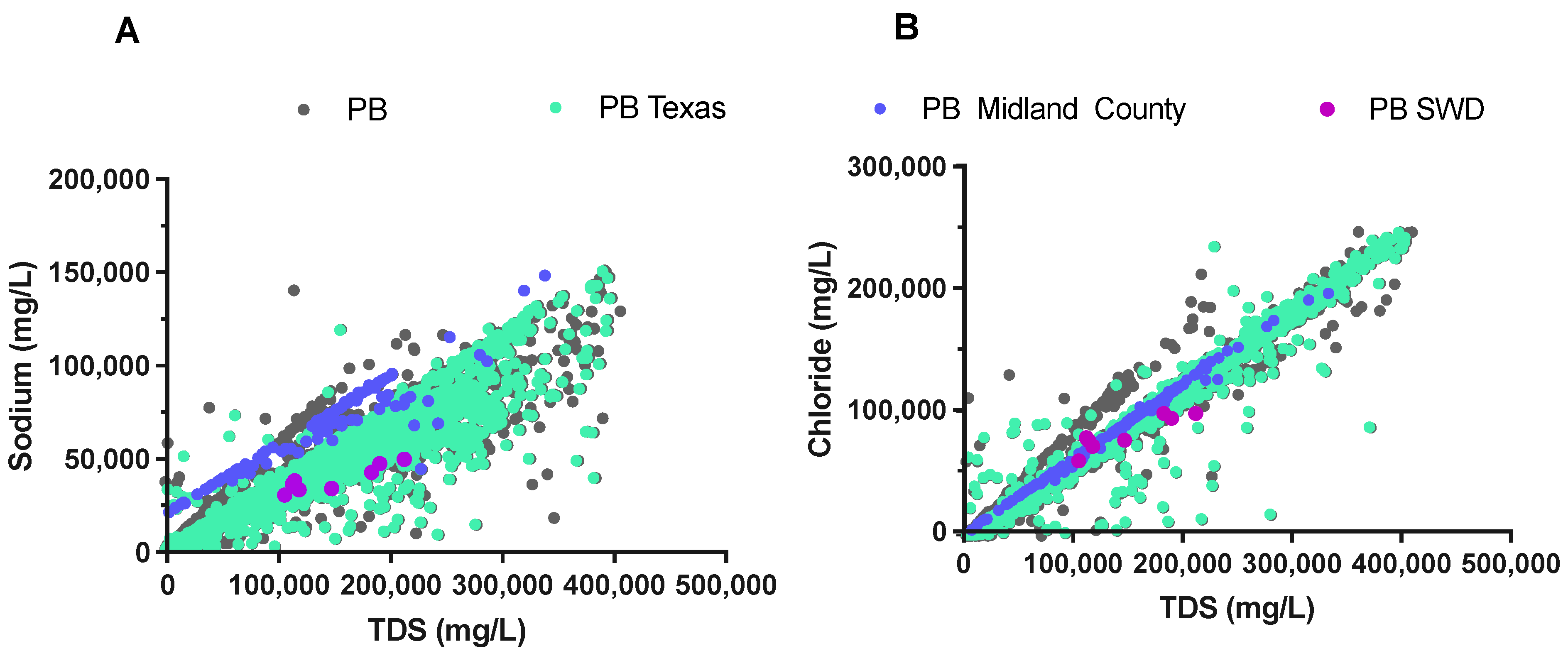
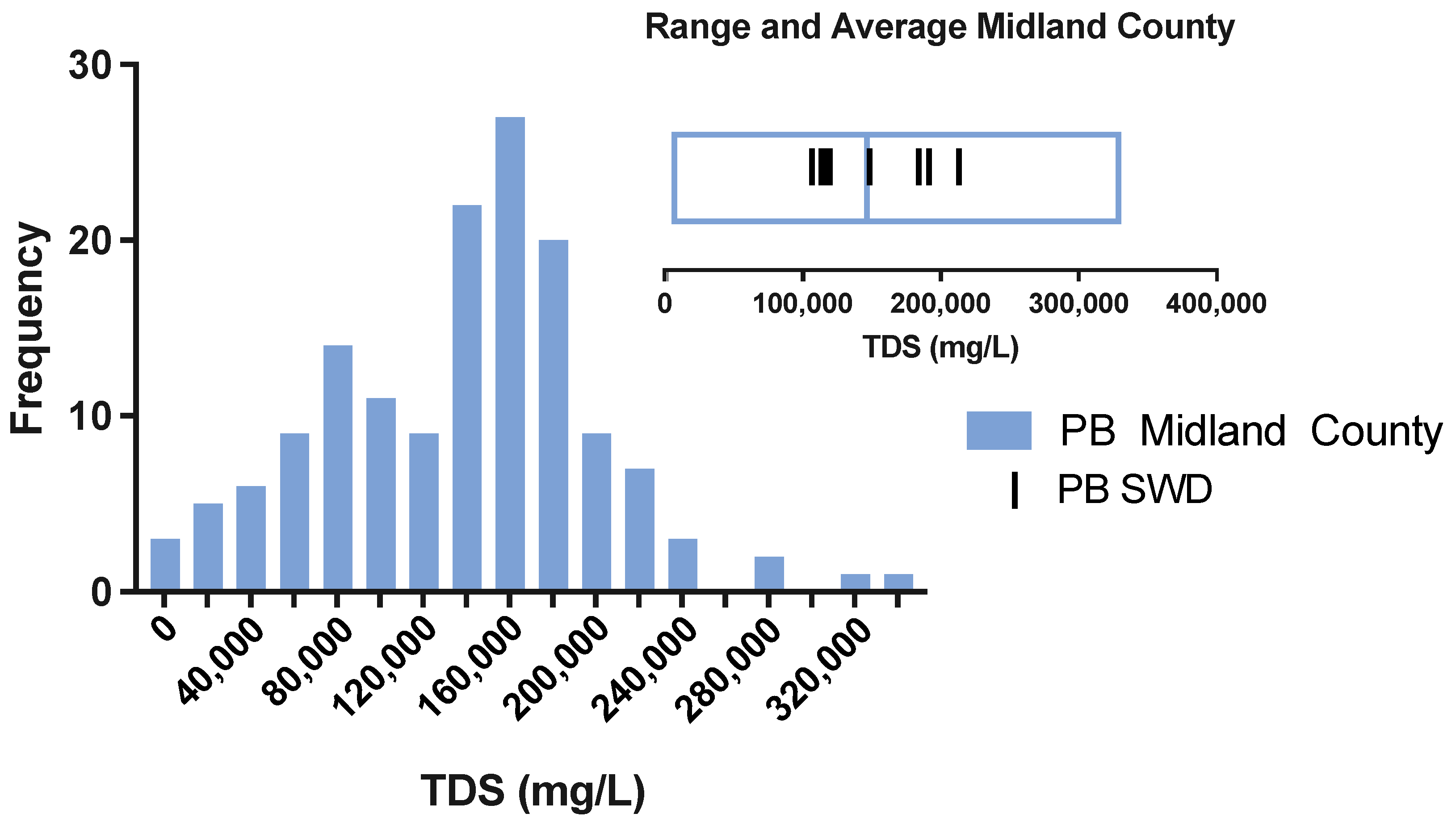
| Production Well Stimulation (mg/L) | Production Concern | |
|---|---|---|
| pH | 6.5–8.5 | Corrosion/Scaling |
| TSS | 500 | |
| Chloride | 30,000–50,000 | Fluid instability |
| Sulfate | 500 | Scaling/Bacterial substrate |
| Bicarbonate | 300 | Scaling |
| Silica | 35 | Scaling |
| Boron (B) | 10 | Crosslinker efficiency |
| Barium (Ba) | 20 | Scaling |
| Calcium (Ca) | 2000 | Scaling |
| Iron (Fe) | 10 | Crosslinker efficiency |
| Magnesium (Mg) | 2000 | Scaling |
Publisher’s Note: MDPI stays neutral with regard to jurisdictional claims in published maps and institutional affiliations. |
© 2022 by the authors. Licensee MDPI, Basel, Switzerland. This article is an open access article distributed under the terms and conditions of the Creative Commons Attribution (CC BY) license (https://creativecommons.org/licenses/by/4.0/).
Share and Cite
Liden, T.; Hildenbrand, Z.L.; Sanchez-Rosario, R.; Schug, K.A. Characterizing Various Produced Waters from Shale Energy Extraction within the Context of Reuse. Energies 2022, 15, 4521. https://doi.org/10.3390/en15134521
Liden T, Hildenbrand ZL, Sanchez-Rosario R, Schug KA. Characterizing Various Produced Waters from Shale Energy Extraction within the Context of Reuse. Energies. 2022; 15(13):4521. https://doi.org/10.3390/en15134521
Chicago/Turabian StyleLiden, Tiffany, Zacariah L. Hildenbrand, Ramon Sanchez-Rosario, and Kevin A. Schug. 2022. "Characterizing Various Produced Waters from Shale Energy Extraction within the Context of Reuse" Energies 15, no. 13: 4521. https://doi.org/10.3390/en15134521
APA StyleLiden, T., Hildenbrand, Z. L., Sanchez-Rosario, R., & Schug, K. A. (2022). Characterizing Various Produced Waters from Shale Energy Extraction within the Context of Reuse. Energies, 15(13), 4521. https://doi.org/10.3390/en15134521







